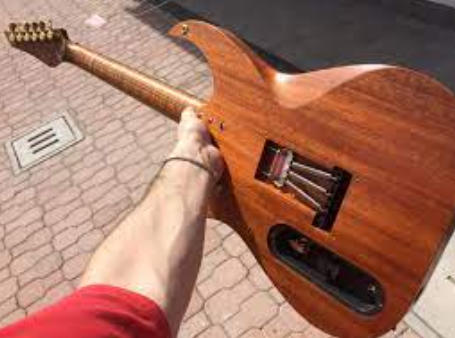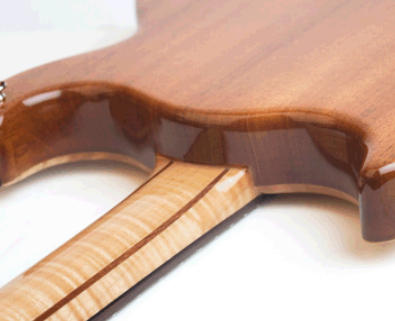Views: 222 Author: Rebecca Publish Time: 2025-10-22 Origin: Site











Content Menu
● Characteristics of Wenge Wood
>> Tactile and Acoustical Response
● Stability and Structural Performance
>> Dimensional Stability in Climate Changes
>> Stiffness and Neck Reinforcement
>> Inherent Strength and No Dead Spots
● Construction Techniques and Luthier Considerations
>> Neck Construction and Assembly
● Tonal Comparisons: Wenge vs. Alternatives
● Best Practices for Wenge Neck Longevity
● FAQs
>> 1. Is Wenge more stable than Maple?
>> 2. What is the best finish for Wenge?
>> 3. Does Wenge require grain filling before finishing?
>> 4. Is Wenge safe to handle?
>> 5. How does Wenge sound compared to Rosewood?
When it comes to guitar building, wood choice is far more than an aesthetic decision—it defines tone, playability, and long-term reliability. Among various exotic hardwoods, Wenge (Millettia laurentii) stands out as a top-tier material favored by luthiers worldwide. Known for its dark chocolate-to-black streaked color and natural oil content, Wenge offers a combination of hardness, visual beauty, and tonal clarity.
The real question, however, is this: how stable is Wenge wood for guitar necks? Through examining its physical properties, tonal responses, workability, and maintenance, we can determine whether Wenge is truly the right choice for custom instruments.

Wenge is an African hardwood with a Janka hardness rating of approximately 8,600 N (1,930 lbf) and a density around 870 kg/m³. These figures place it among the densest tonewoods used in luthiery, surpassing mahogany and even maple in rigidity. Its structural resilience naturally resists warping, bowing, or torsional movement—qualities vital for maintaining string tension over time.[10][11]
Visually, Wenge is one of the most striking woods available. Its dark brown base interspersed with black veins creates an elegant, textured appearance that ages gracefully. Due to its natural beauty, most builders forgo heavy finishing, opting instead for an oiled surface that highlights its grain.
The tactile experience of Wenge is as notable as its look. Its porous surface and subtle oiliness produce a naturally smooth feel ideal for fast neck movements. Acoustically, it exhibits bright mid-range clarity, deep low frequencies, and excellent sustain, a reason many players describe it as sharp yet full-bodied.[11][10]
One of Wenge's strongest qualities lies in its dimensional stability. It has a low coefficient of expansion, meaning that it reacts minimally to changes in humidity and temperature. This makes it well-suited for players who perform in a wide range of environments—from humid outdoor festivals to arid studio conditions.[12]
The high stiffness-to-weight ratio in Wenge contributes to excellent neck reinforcement. Even under high-tension conditions (such as 5-string bass setups or baritone guitars), Wenge maintains its shape remarkably well, rarely requiring frequent truss rod adjustments. Warwick, a premium German bass manufacturer, relies heavily on Wenge for this reason.[13]
Because of its density, Wenge provides superior sustain and reduces the risk of “dead spots” on the fretboard—notes that drop off quickly or sound muted due to uneven vibrational resonance. This mechanical solidity translates to tonal reliability, allowing for consistent sound output across all registers.
Tonally, Wenge is as articulate as it is strong. It combines the crisp high-end clarity often found in maple with the warmth and resonance typical of rosewood:
- Low Frequencies: Deep, resonant, and full-bodied.
- Midrange: Focused with good articulation, ideal for complex chord playing.
- High End: Crisp without harsh overtones.[4][10]
This balanced frequency response works well for both electric guitars and acoustic builds, producing a sound that emphasizes clarity, sustain, and punch.
Luthier Ervin Somogyi describes Wenge as having a “vitreous” vibrational character, meaning it transmits energy efficiently through its rigid yet brittle structure. This brittleness creates a “glass-like” resonance that enhances harmonics, similar to highly sought Brazilian rosewood. However, it also demands careful craftsmanship, as improper machining can cause splintering.[7]
Building with Wenge requires precision. Its fibrous grain can splinter easily, and the wood's brittleness means tools must stay extremely sharp. Luthiers recommend:
- Using carbide-tipped blades for cutting.
- Sanding with high-grit papers up to 2500 for a glass-like finish.[1]
- Avoiding aggressive planing or high-speed routing to prevent tear-out.
The high silica content can dull tools quickly, but the reward is a neck that requires little to no finishing, retaining its tactile smoothness.
Wenge is often used either as a solid one-piece neck or as laminations combined with maple, mahogany, or bubinga for visual flair and added stiffness. A laminated Wenge neck not only looks stunning but also mitigates any risk of warping.
Builders also highlight that Wenge necks, when properly quarter-sawn, have a natural resistance to twisting, reducing the need for carbon inserts.
Wenge's dark coloration serves as a contrasting base for metallic or shell inlays. Builders often pair it with brass or copper fret markers, which accentuate its deep tones beautifully. CNC machining allows precision cutting for fret slots, though slow feed rates are advised to minimize chipping.[3]

Wenge necks are typically left unfinished or sealed with drying oils rather than hard varnishes. Mineral oil is not recommended because it never fully dries; instead, tung oil or Tru-Oil are preferred choices. A few luthiers use thin shellac coatings for added humidity protection without compromising the natural touch.[6][9][1]
To achieve a natural sheen:
1. Sand the surface gradually up to 2000+ grit.
2. Apply a light oil coat using a soft cloth twice daily for two days.
3. Buff with dry microfiber to achieve a low-gloss luster.
This approach preserves Wenge's tactile feel while adding resistance to sweat or grime accumulation.
- Reapply oil or wax annually or as needed to refresh the finish.
- Avoid heavy solvent cleaners that strip natural oils.
- Clean gently with a damp microfiber cloth after each performance.
- If residue builds up, use lemon oil sparingly.
Because of its open pores, Wenge tends to hold tiny particles over time. However, this doesn't compromise neck performance and can enhance grip when polished correctly.
Wenge's primary drawback is its tendency to splinter. Woodworkers must use masks and gloves, as Wenge splinters are sharp and may cause skin irritation or infection if not handled promptly. For safety, vacuum extraction systems and protective gear are strongly advised.[8]
Although Wenge can bend under heat, it needs to be done slowly and precisely. Luthiers who craft bouzoukis and mandolins note that Wenge initially bends easily but can resist secondary corrections—meaning that once bent, it holds shape firmly but allows little flexibility afterward.[5]
| Attribute | Wenge | Maple | Mahogany | Rosewood |
|---|---|---|---|---|
| Hardness (Janka) | 8,600 N | 6,400 N | 4,200 N | 7,800 N |
| Density (kg/m³) | 870 | 705 | 545 | 820 |
| Tonal Character | Deep lows, tight mids, crisp highs | Bright, clear | Warm, soft | Dark, smooth |
| Workability | Challenging (brittle) | Easy | Moderate | Hard |
| Finish Type | Oil only | Gloss, satin | Gloss | Oil |
| Stability | Excellent | Good | Moderate | Good |
This comparison reinforces that Wenge rivals traditional tonewoods not only in strength but also in tonal versatility.
- Keep the guitar in moderate humidity (between 40–60%).
- Avoid prolonged exposure to direct sunlight or extreme cold.
- If left unfinished, refresh oiling periodically.
- Store in a padded hard case to reduce impact stress.
Following these simple practices will preserve both Wenge's finish and its natural stability for decades.
Wenge wood stands as one of the most stable and sonically dynamic materials available for guitar necks. Its density ensures structural integrity, while its natural oils protect it from climate fluctuations. Although challenging to machine, its end results—enhanced sustain, tonal richness, and unmatched durability—make it a favorite among professionals.
From boutique builders to major brands, Wenge's reputation is not just hype—it's earned through decades of reliable performance and tonal excellence. Whether for electric, acoustic, or bass guitars, a well-crafted Wenge neck will deliver both beauty and resilience over a lifetime of music-making.

Yes. Wenge's higher oil content and greater stiffness offer superior resistance against warping, even in fluctuating climates.[10][12]
Drying oils like Tung oil or Tru-Oil work best. Avoid mineral oil, as it never cures and can trap dirt on the surface.[1][6]
No. Its open pores provide natural texture, which most luthiers prefer to leave unfilled for a raw, organic look.[6]
Use protective gear. Wenge dust can cause mild respiratory or skin irritation, especially during sanding, due to its silica and natural phenols.[8]
Wenge's sound is slightly brighter and tighter than rosewood, offering faster attack while maintaining rich harmonic sustain.[11][10]
[1](https://www.reddit.com/r/Luthier/comments/y7dnys/advice_how_to_finish_my_wenge_neck/)
[2](https://www.facebook.com/groups/8471017506/posts/10157702658737507/)
[3](https://www.youtube.com/watch?v=1lbPS71TFik)
[4](https://www.projectguitar.com/forums/topic/47294-wenge-neck-tone-properties/)
[5](https://www.nkforsterguitars.com/uncategorized/happy-2021-build-thread-wenge-spruce-irish-bouzouki/)
[6](https://unofficialwarmoth.com/threads/wenge-finishing-tips-suggestions.7678/)
[7](https://esomogyi.com/using-wenge-as-a-guitar-wood/)
[8](https://www.youtube.com/watch?v=ChAQV62AWpA)
[9](https://www.talkbass.com/threads/how-do-you-finish-your-wenge-necks.188829/)
[10](https://www.prosono-hardwoods.com/blog/wenge-for-guitar-an-amazing-and-often-overlooked-acoustic-tonewood/)
[11](https://www.wood-database.com/wenge/)
[12](https://www.facebook.com/groups/8471017506/posts/10158501138387507/)
[13](https://www.youtube.com/watch?v=7PN02hkFV3U)
[14](https://ploutone.com/products/wenge-strat-replacement-neck-9-5-radius)
[15](https://www.youtube.com/watch?v=rMsrW0XDnLE)